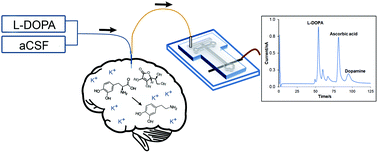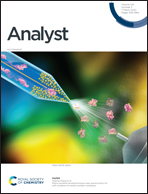Progress toward the development of a microchip electrophoresis separation-based sensor with electrochemical detection for on-line in vivo monitoring of catecholamines
Abstract
The development of a separation-based sensor for catecholamines based on microdialysis (MD) coupled to microchip electrophoresis (ME) with electrochemical (EC) detection is described. The device consists of a pyrolyzed photoresist film working electrode and a poly(dimethylsiloxane) microchip with a flow-gated sample injection interface. The chip was partially reversibly sealed to the glass substrate by selectively exposing only the top section of the chip to plasma. This partially reversible chip/electrode integration process not only allows the reuse of the working electrode but also greatly enhanced the reproducibility of electrode alignment with the separation channel. The developed MD–ME–EC system was then tested using L-DOPA, 3-O-MD, HVA, DOPAC, and dopamine standards, which were separated in less than 100 seconds using a background electrolyte consisting of 15 mM sodium phosphate (pH 7.4), 15 mM sodium dodecyl sulfate, and 2.5 mM boric acid. A potential of +1.0 V vs. Ag/AgCl was used for amperometric detection of the analytes. The device was evaluated for on-line monitoring of the conversion of L-DOPA to dopamine in vitro and for monitoring dopamine release in an anesthetized rat in vivo following high K+ stimulation. The system was able to detect stimulated dopamine release in vivo but not endogenous levels of dopamine.

- This article is part of the themed collection: Analytical Science in Neurochemistry


 Please wait while we load your content...
Please wait while we load your content...